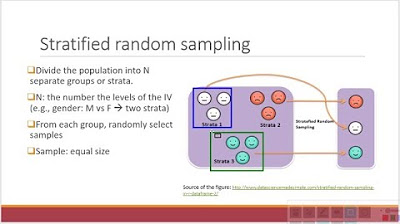Types of sampling methods with examples / sampling techniques (8)
TLDRThis educational video explores various sampling methods in research methodology, essential for statistical analysis. It delves into Probability Sampling, including Simple Random, Systematic, Stratified, and Clustered sampling, each offering unique ways to ensure representativeness and efficiency. The video also covers Non-Probability Sampling techniques like Convenience, Quota, Judgement, and Snowball sampling, which rely on researcher's judgment rather than random selection. Examples are provided to illustrate each method, highlighting their applications and benefits in different research scenarios.
Takeaways
- 📊 Sampling is a statistical process used to obtain a subset of observations from a larger population.
- 🔍 The choice of sampling method depends on the type of analysis being performed.
- 🎯 Probability sampling ensures every individual in the population has an equal chance of being selected.
- 🔮 Simple random sampling involves selecting items by chance, making it time and cost-efficient.
- 📝 Systematic sampling involves selecting elements at regular intervals after a random start, useful for large populations.
- 🏥 Stratified sampling divides the population into subgroups and ensures representation from each.
- 🌐 Clustered sampling uses subgroups as sampling units, which can be efficient in wide geographical areas.
- 🚫 Non-probability sampling is based on the researcher's judgment and does not offer equal selection chances for all.
- 🛍️ Convenience sampling is chosen for its ease and speed, often used for pre-testing or quick reactions.
- 🎯 Quota sampling involves selecting individuals based on specific characteristics to represent the population.
- 👁️ Judgement or purposive sampling relies on the researcher's discretion to select individuals with certain traits.
- ❄️ Snowball sampling starts with a few samples and expands by referrals, useful for studying hard-to-reach groups.
Q & A
What is sampling in research methodology?
-Sampling in research methodology is a process used in statistical analysis where a predetermined number of observations are obtained from a larger population to perform analysis.
What does the term 'probability sampling' refer to?
-Probability sampling is a sampling technique where every individual in the population has an equal chance of being selected for the sample.
How is simple random sampling defined?
-Simple random sampling is a technique where each item in the population has an equal chance and probability of being selected from the sample, and the selection depends completely on chance or probability.
Can you provide an example of simple random sampling?
-An example of simple random sampling is when a hospital with 1000 employees needs to allocate the night shift to 100 members, and all employee names are put in a bucket to be selected at random.
What is systematic sampling and how is it implemented?
-Systematic sampling is a probability sampling method where elements from a target population are chosen by selecting a random starting point and then selecting other members after a fixed sampling interval, calculated by dividing the total population size by the desired sample size.
What is stratified sampling and why is it used?
-Stratified sampling is a method where the population is divided into subgroups (strata) that share a similar characteristic, and it is used to ensure representation of all subgroups when the measure of interest is expected to vary between them.
How does clustered sampling differ from other sampling methods?
-Clustered sampling differs by using subgroups of the population, known as clusters, as a sampling unit rather than individuals. Each cluster is treated as a small population with all the attributes of the larger population.
What is non-probability sampling and how does it differ from probability sampling?
-Non-probability sampling is a technique where the researcher selects samples based on subjective judgment rather than random selection, meaning not all members of the population have the same chance to participate in the study.
Can you explain convenience sampling and its common use cases?
-Convenience sampling is a non-probability technique where samples are selected because they are easily available to the researcher. It is often used in pre-testing questionnaires or when quick reactions to a product concept are needed.
What is quota sampling and how does it work?
-Quota sampling is a non-probability method where researchers create a sample involving individuals who represent a population, choosing them according to specific characteristics or qualities and ideally proportionally representing the characteristics of the underlying population.
How is judgement or purposive sampling conducted?
-Judgement or purposive sampling depends on the researcher's judgment when choosing participants. It is often used to implicitly choose a representative sample or specifically target individuals with certain characteristics.
What is snowball sampling and when is it typically used?
-Snowball sampling is a technique where the researcher starts with a few samples and then asks them to recommend other subjects who fit the description needed. It is commonly used in social sciences when investigating hard-to-reach groups.
Outlines
🔍 Introduction to Sampling Methods
This paragraph introduces the concept of sampling in research methodology, emphasizing its importance in statistical analysis. It explains that the method of sampling depends on the type of analysis being conducted. The speaker encourages viewers to watch the entire video for a comprehensive understanding of different sampling techniques, including examples. The paragraph outlines two main categories of sampling: Probability Sampling and Non-probability Sampling, and briefly mentions Simple Random Sampling as the first type of Probability Sampling, highlighting its equal chance selection process.
📚 Detailed Exploration of Probability Sampling Techniques
This paragraph delves into the specifics of Probability Sampling, which ensures every individual in the population has an equal chance of being selected. It discusses three types: Simple Random Sampling, where selection is purely by chance, exemplified by a hospital allocating night shifts; Systematic Sampling, where elements are chosen at regular intervals after a random start, illustrated with a student opinion survey; and Stratified Sampling, which involves dividing the population into subgroups with similar characteristics before sampling, as shown in a study of nursing staff health outcomes. Each method is explained with practical examples to clarify their applications and benefits.
🌐 Understanding Clustered and Non-probability Sampling
The third paragraph introduces Clustered Sampling, where subgroups or clusters of the population are sampled instead of individuals, making it efficient for widespread geographical studies. An example of studying smartphone use among art students in India is provided. The paragraph then transitions to Non-probability Sampling, which is based on the researcher's judgment rather than random selection. It outlines four types: Convenience Sampling, where easily accessible subjects are chosen; Quota Sampling, which involves selecting individuals based on specific characteristics to represent the population; Judgement or Purposive Sampling, which relies on the researcher's discretion to select participants; and Snowball Sampling, used to study hard-to-reach groups by asking initial subjects to recommend others. Each non-probability method is detailed with examples to demonstrate their use and rationale.
Mindmap
Keywords
💡Sampling
💡Probability Sampling
💡Simple Random Sampling
💡Systematic Sampling
💡Stratified Sampling
💡Clustered Sampling
💡Non-probability Sampling
💡Convenience Sampling
💡Quota Sampling
💡Judgement or Purposive Sampling
💡Snowball Sampling
Highlights
Sampling is a process used in statistical analysis to obtain a predetermined number of observations from a larger population.
The methodology for collecting samples depends on the type of analysis being performed.
Probability sampling offers all individuals in the population an equal chance of being selected.
Simple random sampling is a method where each item in the population has an equal chance of being selected.
Systematic sampling involves selecting elements at regular intervals after a random starting point.
Stratified sampling divides the population into subgroups that share a similar characteristic.
Clustered sampling uses subgroups of the population as a sampling unit.
Non-probability sampling is based on the researcher's subjective judgment rather than random selection.
Convenience sampling selects samples that are easily available to the researcher.
Quota sampling involves creating a sample that proportionally represents the characteristics of the population.
Judgement or purposive sampling depends on the researcher's judgment to select participants.
Snowball sampling involves recruiting subjects who recommend others fitting the sample description.
Probability sampling is suitable for studies requiring a representative sample.
Non-probability sampling is useful for quick reactions and when the population is hard to reach.
Examples provided illustrate the practical applications of different sampling methods.
The video offers a comprehensive guide to choosing the right sampling method for research.
Different examples are provided for each sampling method to enhance understanding.
The video concludes with a call to action for viewers to subscribe and share the content.
Transcripts
Browse More Related Video

Probability and Non-Probability Sampling in Research Methods

Sampling: Sampling & its Types | Simple Random, Convenience, Systematic, Cluster, Stratified

Sampling Methods 101: Probability & Non-Probability Sampling Explained Simply

Research Methods 1: Sampling Techniques

What Are The Types Of Sampling Techniques In Statistics - Random, Stratified, Cluster, Systematic

Statistics Lecture 1.5: Sampling Techniques. How to Develop a Random Sample
5.0 / 5 (0 votes)
Thanks for rating: